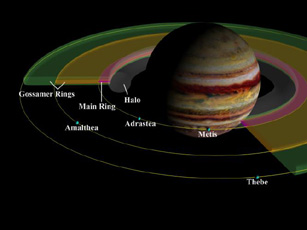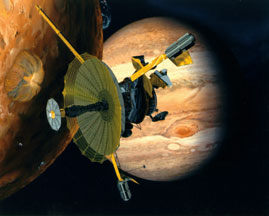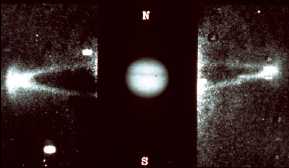Galileo Cruises the Inner Jovian System
Galileo is a spacecraft that is orbiting Jupiter. It has been there since 1995. On November 5, 2002, Galileo went very close to Jupiter. It made measurements of the radiation near Jupiter. There is an animation on this page that shows where Galileo went, and what the measurements it made were like.
You need to have the newest version of the Flash player on your computer to see this animation.
Galileo went very close to Jupiter. Jupiter has
moons, but you can only
see the five that are closest to Jupiter
(Adrastea, Metis, Amalthea, Thebe, and Io) in this animation. You can also see Jupiter's
rings. There are three
parts to Jupiter's rings. The Halo Ring is closest to Jupiter. Next is the
Main Ring. The Gossamer Ring is the furthest away from Jupiter.
There is a lot of radiation near Jupiter. There are also very strong magnetic
fields. Most people think that space is empty. The space near Jupiter is not
empty; it is filled with dust and radiation and magnetic fields!
You might also be interested in:

Galileo was a spacecraft that orbited Jupiter for eight years. It made many discoveries about Jupiter and its moons. Galileo was launched in 1989, and reached Jupiter in 1995. The spacecraft had two parts.
...more
Adrastea is a small moon of Jupiter. Of Jupiter's 60 moons, it is the second closest to the planet. Adrastea was discovered by David Jewitt and Ed Danielson of the Voyager team in 1979. Adrastea is tiny
...more
Amalthea was discovered by E Barnard in 1872. Of the 17 moons it is the 3rd closest to Jupiter. Amalthea is about the size of a county or small state. Amalthea is named after the goat in Greek mythology
...more
You may think Saturn is the only planet with rings. It is not! Jupiter has rings, too. They aren't as easy to see as Saturn's, but they are there! Saturns rings are made of ice and are very bright. Jupiter's
...more
The force of magnetism causes material to point along the direction the magnetic force points. Here's another picture of how this works. This picture shows where the magnetic poles of the Earth are to
...more
Galileo is a spacecraft that has been orbiting Jupiter for eight years. On September 21, 2003, Galileo will crash into Jupiter. It will burn up in Jupiter's atmosphere. The crash is not an accident! The
...more
A satellite which has an atmosphere, such as Jupiter's moon Io, and which also is inside a magnetosphere (unlike the Earth's moon), will leave a cloud of particles behind as it orbits the planet. This
...more













